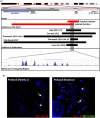Deletion of conserved non-coding sequences downstream from NKX2-1: A novel disease-causing mechanism for benign hereditary chorea
- PMID: 33666368
- PMCID: PMC8123744
- DOI: 10.1002/mgg3.1647
Deletion of conserved non-coding sequences downstream from NKX2-1: A novel disease-causing mechanism for benign hereditary chorea
Abstract
Background: Benign hereditary chorea (BHC) is an autosomal dominant disorder characterized by early-onset non-progressive involuntary movements. Although NKX2-1 mutations or deletions are the cause of BHC, some BHC families do not have pathogenic alterations in the NKX2-1 gene, indicating that mutations of non-coding regulatory elements of NKX2-1 may also play a role.
Methods and results: By using whole-genome microarray analysis, we identified a 117 Kb founder deletion in three apparently unrelated BHC families that were negative for NKX2-1 sequence variants. Targeted next generation sequencing analysis confirmed the deletion and showed that it was part of a complex local genomic rearrangement. In addition, we also detected a 648 Kb de novo deletion in an isolated BHC case. Both deletions are located downstream from NKX2-1 on chromosome 14q13.2-q13.3 and share a 33 Kb smallest region of overlap with six previously reported cases. This region has no gene but contains multiple evolutionarily highly conserved non-coding sequences.
Conclusion: We propose that the deletion of potential regulatory elements necessary for NKX2-1 expression in this critical region is responsible for BHC phenotype in these patients, and this is a novel disease-causing mechanism for BHC.
Keywords: NKX2-1; benign hereditary chorea; chromosome 14q13.2-q13.3; copy number variations; non-coding regulatory elements.
© 2021 The Authors. Molecular Genetics & Genomic Medicine published by Wiley Periodicals LLC.
Conflict of interest statement
The authors declare no conflict of interest.
Figures



References
-
- Barnett, C. P. , Mencel, J. J. , Gecz, J. , Waters, W. , Kirwin, S. M. , Vinette, K. M. B. , Uppill, M. , & Nicholl, J. (2012). Choreoathetosis, congenital hypothyroidism and neonatal respiratory distress syndrome with intact NKX2‐1. American Journal of Medical Genetics Part A, 158A(12), 3168–3173. 10.1002/ajmg.a.35456 - DOI - PubMed
-
- Breedveld, G. J. , van Dongen, J. W. , Danesino, C. , Guala, A. , Percy, A. K. , Dure, L. S. , Harper, P. , Arts, W. F. , Lazarou, L. P. , Van Der Linde, H. , de Vries, B. , Joosse, M. , & Heutink, P. (2002). Mutations in TITF‐1 are associated with benign hereditary chorea. Human Molecular Genetics, 11(8), 971–979. 10.1093/hmg/11.8.971 - DOI - PubMed
-
- Dale, R. C. , Grattan‐Smith, P. , Nicholson, M. , & Peters, G. B. (2012). Microdeletions detected using chromosome microarray in children with suspected genetic movement disorders: a single‐centre study. Developmental Medicine & Child Neurology, 54(7), 618–623. 10.1111/j.1469-8749.2012.04287.x - DOI - PubMed
Publication types
MeSH terms
Substances
Grants and funding
LinkOut - more resources
Full Text Sources
Other Literature Sources

